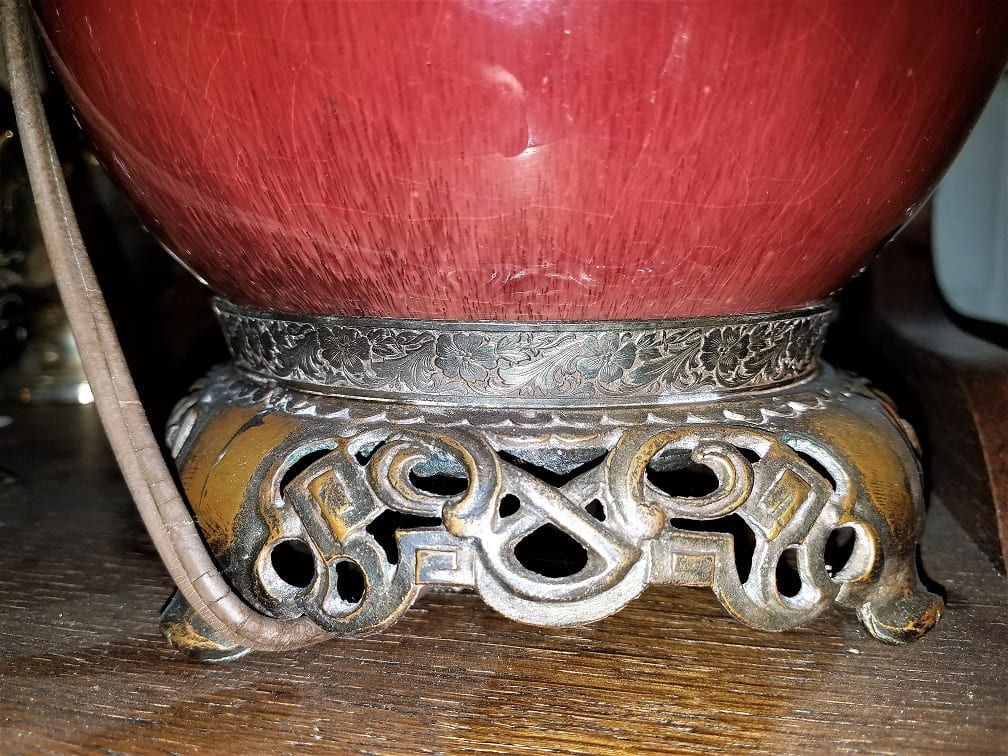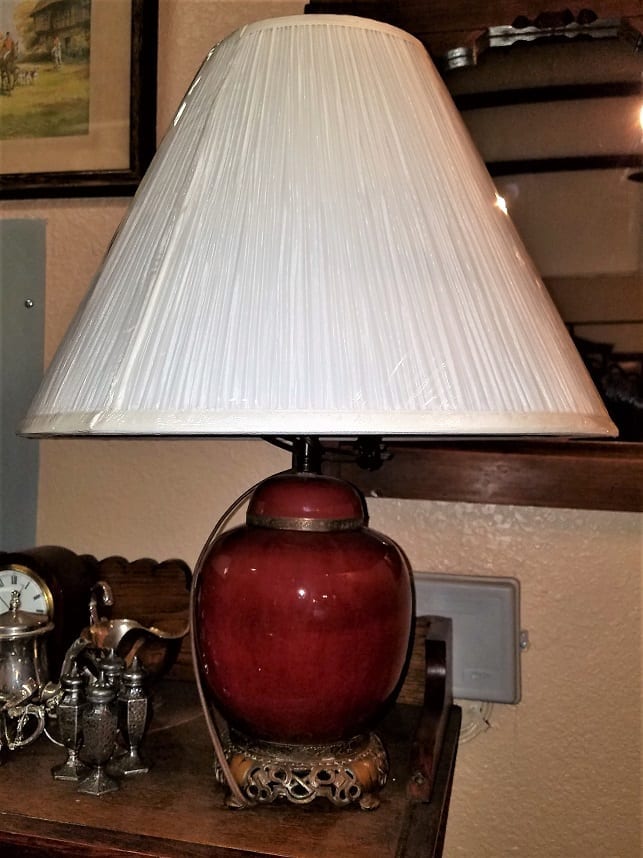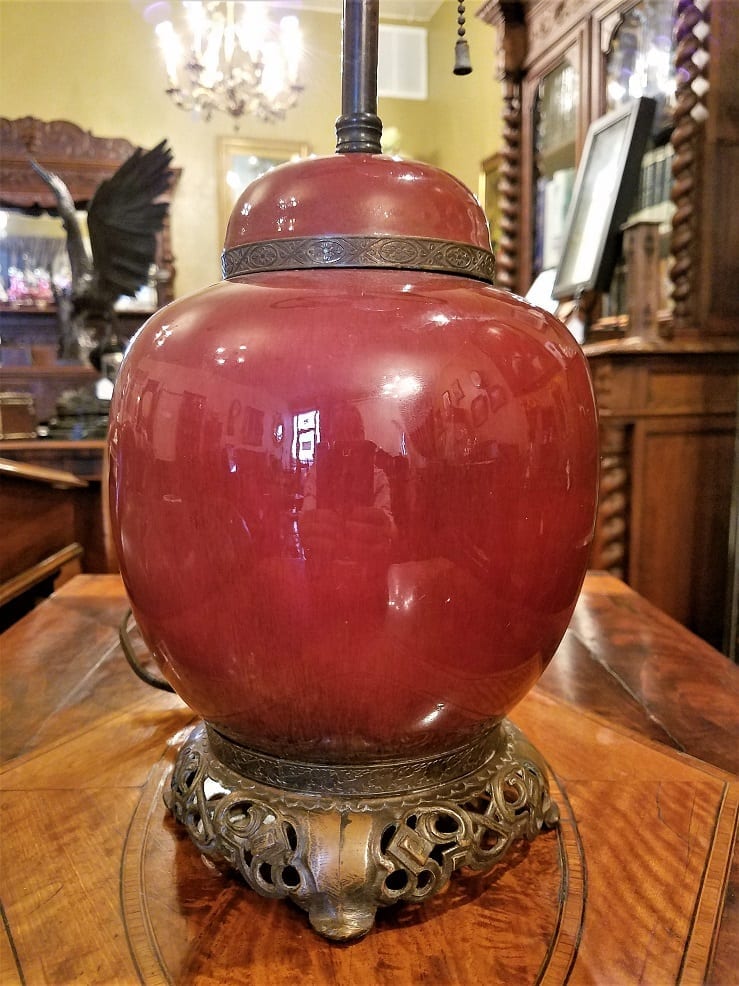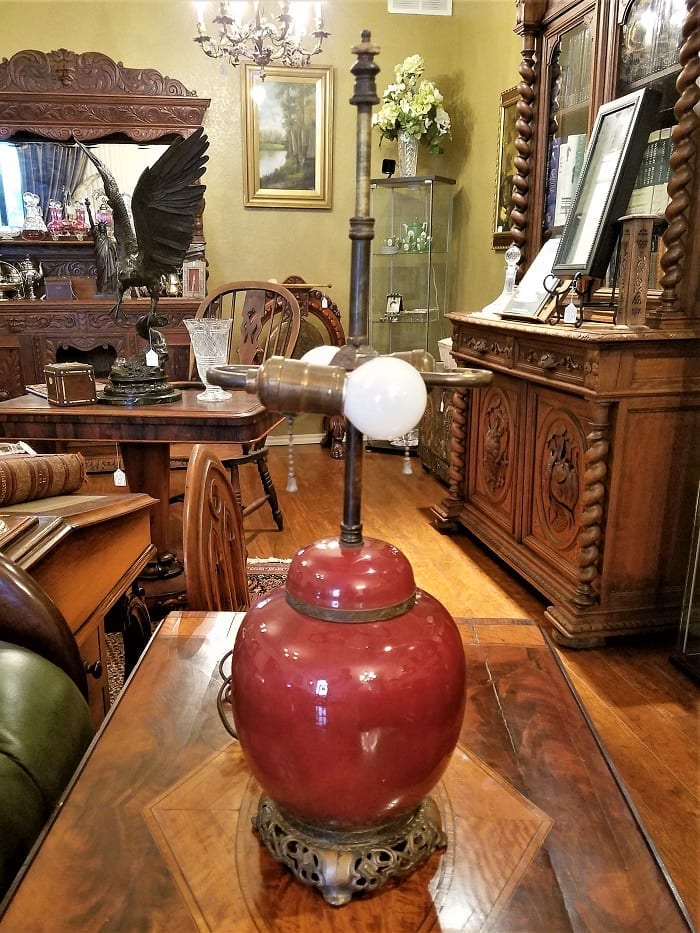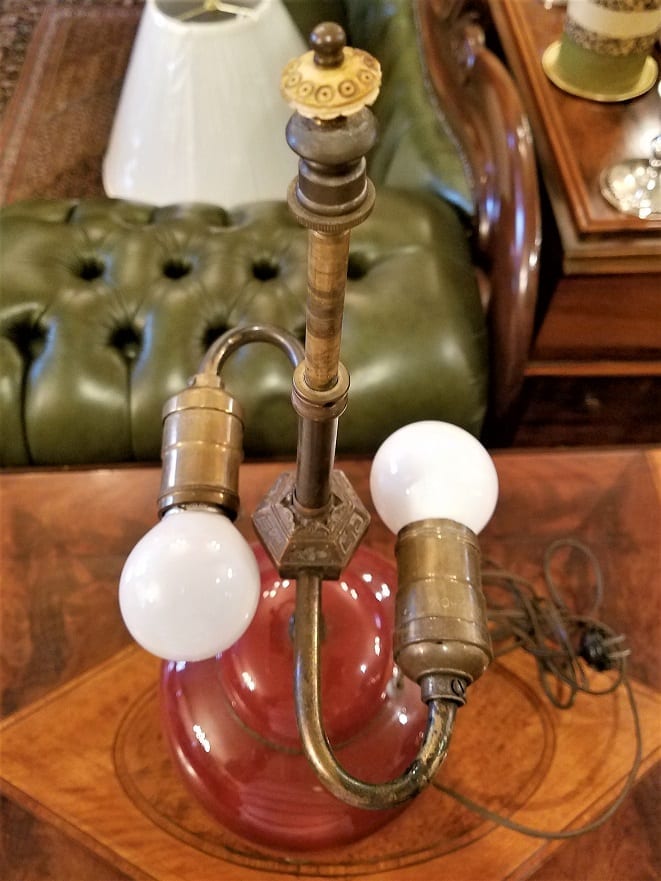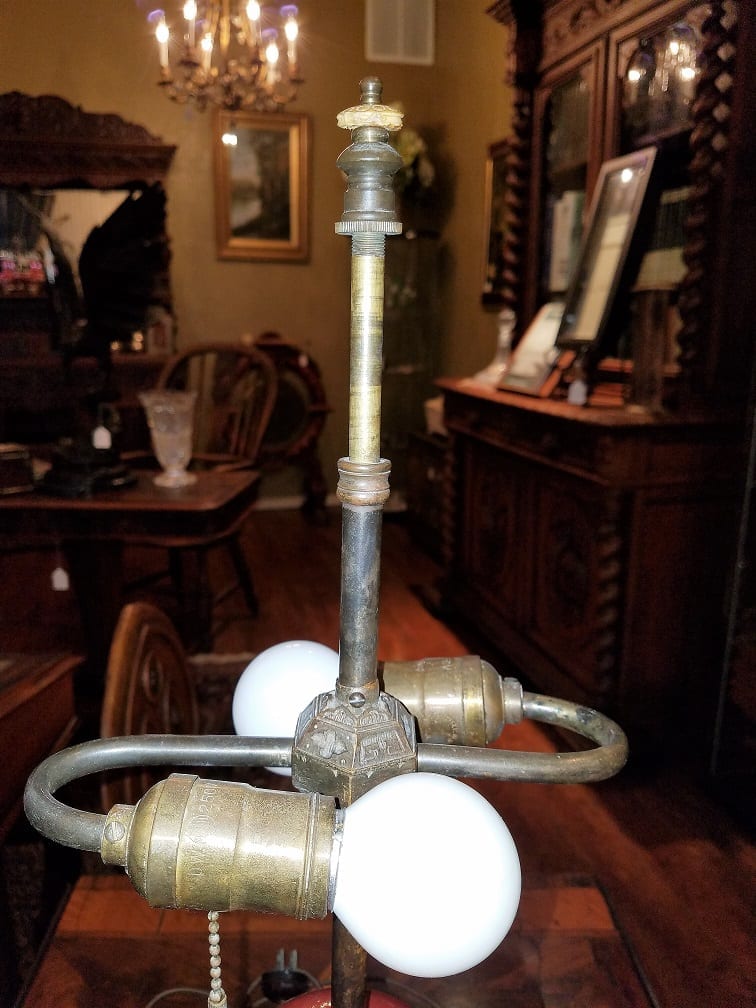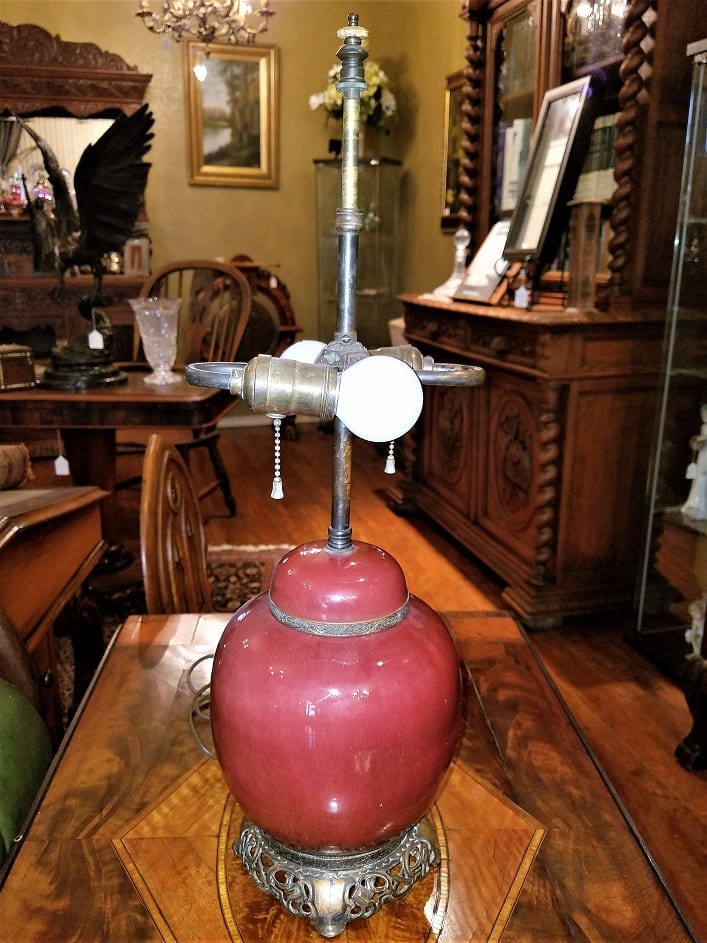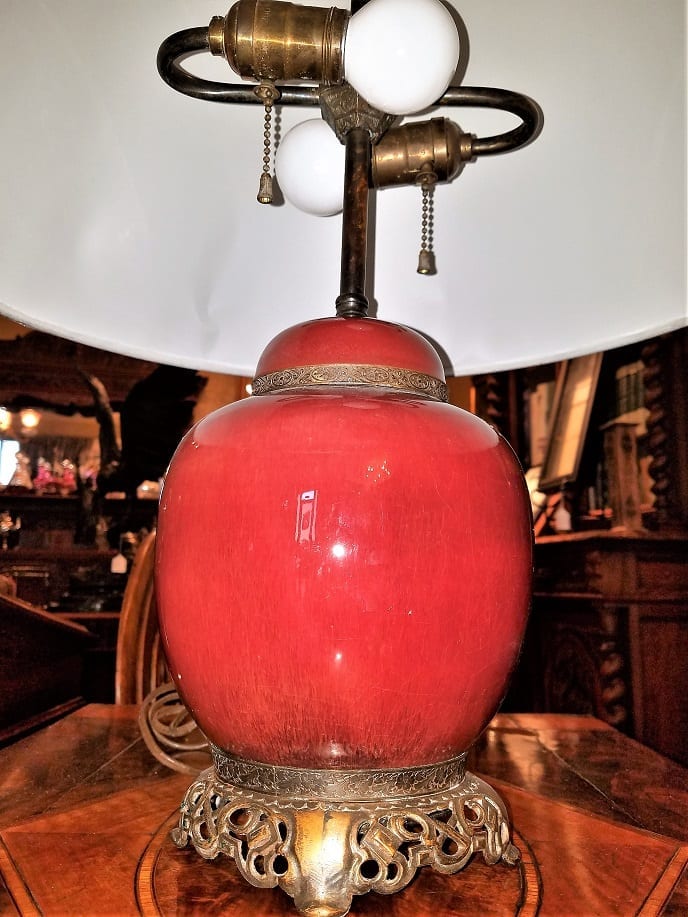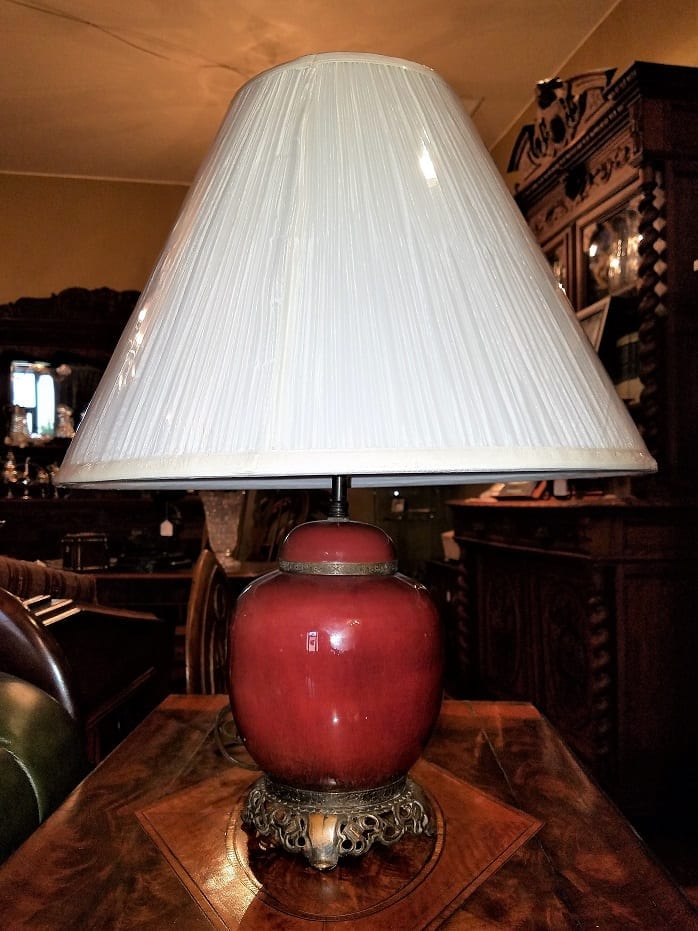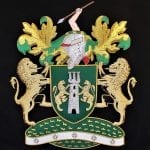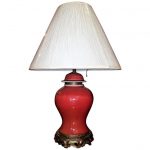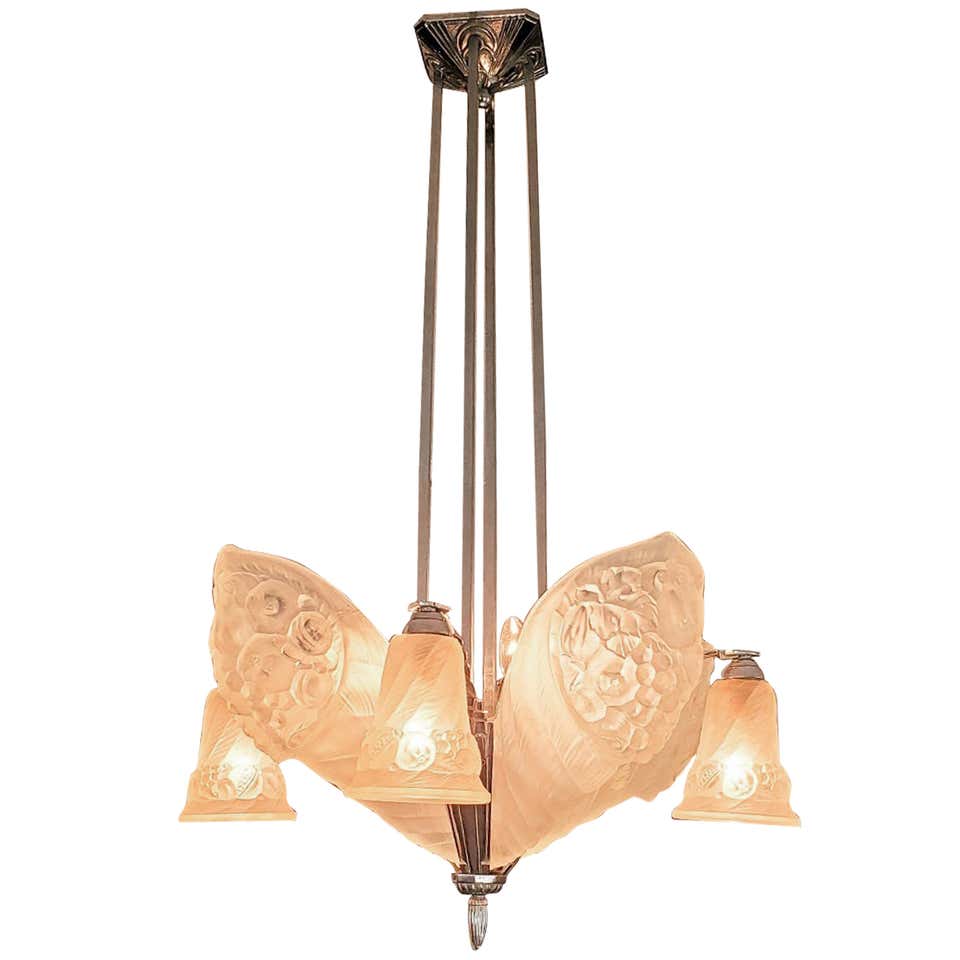Early 20C American Dedham Style Pottery Sang de Boeuf & Gilt Bronze Table Lamp
PRESENTING a GORGEOUS AND EXTREMELY RARE Early 20C American Dedham Pottery Oxblood & Gilt Bronze Table Lamp of Medium proportions.
In the shape of a Lidded Chinese Ginger Jar/Urn, heavily influenced by Chinese design with gilt bronze mounts and base in the Chinese style.
CLASSIC Oxblood or ‘Sang de Boeuf’ Pottery.
From circa 1920 and we believe American made, probably by the Hugh C. Robertson for Dedham Pottery. The fittings are by Hubbell Incorporated.
From our research, Dedham worked closely with Hubbell in supplying electrical components for their lamps. Due to the proven aging of the piece from it’s provenance, coupled with the fact that in the 1920’s Dedham were the main US makers of Oxblood Pottery and that fact added to the Hubbell fittings, we are confident that this is a Dedham piece but we cannot find any marks.
Part of a Dallas Private Collection from the 1920’s and 30’s.
When we re-wired the smaller of the 3 Lamps we have in this Collection, we discovered the Hubbell Label on the inside of the base of the lamp (see photos).
The lamp has 2 bulbs which each has a patented Hubbell Toggle/Chain Switch.
Bone and ball finial.
Extendable arm, for height adjustment.
The shade is new and for display purposes only and not included in the sale.
Fully working condition.
VERY RARE & FUNCTIONAL & COLLECTIBLE LAMP
Oxblood is a color considered to be a dark shade of red. It resembles burgundy, but has more purple and dark brown hues.
The first use of the term oxblood as a color name in the English language dates back to 1695–1705. The name is derived from the color of the blood of an ox. The ox blood was used as a pigment to dye fabric, leather and paint. It is most commonly described as a dark red with purple and brown undertones. The blood would change from a bright red to a darker, oxidized, more brown-red as it aged. The term oxblood can be used to describe a range of colors from red to reddish-purple to nearly black with red, brown and blue undertones.
American art pottery (sometimes capitalized) refers to aesthetically distinctive hand-made ceramics in earthenware and stoneware from the period 1870-1930. Ranging from tall vases to tiles, the work features original designs, simplified shapes, and experimental glazes and painting techniques. Stylistically, most of this work is affiliated with the modernizing Arts and Crafts (1880-1910), Art Nouveau (1890–1910), or Art Deco (1920s) movements. Art pottery was made by some 200 studios and small factories across the country, with especially strong centers of production in Ohio (the Cowan, Lonhuda, Owens, Roseville, Rookwood, and Weller potteries) and Massachusetts (the Dedham, Grueby, Marblehead, and Paul Revere potteries). Most of the potteries were forced out of business by the economic pressures of competition from commercial mass-production companies as well as the advent of World War I followed a decade later by the Great Depression.
The Dedham Pottery, which operated in Dedham, Massachusetts, between 1896 and 1943, was founded by ceramicist Hugh C. Robertson, who had previously worked with his father and brothers at another pottery. Robertson was deeply interested in glazes, and he developed both an oxblood glaze (inspired by a Chinese glaze) and a fine crackle glaze, the latter of which became Dedham’s signature, along with its frequent use of a crouching rabbit motif.
Link: https://en.wikipedia.org/wiki/American_art_pottery
Early 20C American Dedham Pottery Oxblood & Gilt Bronze Table Lamp Large.
Chelsea Keramics Sang-de-boeuf Pottery
Stoneware
Chelsea, Massachusetts.
One of the early innovators of artistic glaze, Hugh Robertson continued the experimentation begun at his earlier venture, the Chelsea Keramic Art Works, in Dedham, Massachusetts, where he moved his re-formed Chelsea Pottery in 1896. Robertson’s celebrated sang-de-boeuf (oxblood) glaze, developed at Chelsea, was influenced by the potter’s early interest in Asian ceramics. To offset the high cost of producing artistic lines, the Dedham Pottery relied on the success of the crackle glaze of its commercial tableware, another Asian-inspired effect, which has become a perennial collecting favorite.
Oxblood Vases by Robertson have sold for thousands at Auction.
Link: https://www.skinnerinc.com/auctions/2870B/lots/267
Hugh C. Robertson, (1845–1908), was an American studio potter who is the first recognized potter to have worked with nonrepresentational ceramic decoration glazes. Robertson apprenticed at the Jersey City Potter in 1860. In 1868, he started work in his father’s shop that opened in 1866 in Chelsea, Massachusetts. In 1872 the factory was incorporated into the Chelsea Keramic Art Works (CKAW). The company became known for their antique Grecian terra cotta and Pompeian bronzes. In 1877, Robertson developed the Chelsea faience, underglazed opaque earthenware, which lead the development of other American faience. There in 1884, Robertson worked on discovering the secret Chinese glaze, Sang-de-Boeuf. In 1888, he finally discovered the recipe for the glaze and produced three hundred pieces of what he dubbed, Sang de Chelses.
The Arts and Crafts, and the Art Pottery Movement owes much to Hugh Robertson – After years of experimentation, and eventual artistic success, Hugh Robertson exhausted the finances of the Chelsea Keramic Art Works and the studio closed in 1889. He did not return to the pottery world until July 17, 1891 when he established Chelsea Pottery, US in Dedham, Massachusetts Robertson later went on to success in 1895, with the Dedham Pottery Company, in good part based on his glaze success’ at the Chelsea Keramic Art Works.
Link: https://en.wikipedia.org/wiki/Hugh_C._Robertson
Hubbell Incorporated was founded by Harvey Hubbell as a proprietorship in 1888, and was incorporated in Connecticut in 1905. Hubbell design, manufacture and sell electrical and electronic products for non-residential and residential construction, industrial and utility applications. The Company’s reporting segments consist of the Electrical segment (comprising electrical systems products and lighting products) and the Power segment. Hubbell’s manufacturing facilities are located in the United States, Canada, Switzerland, Puerto Rico, Mexico, the People’s Republic of China (“China”), Italy, the United Kingdom, Brazil and Australia and maintains sales offices in Singapore, China, India, Mexico, South Korea, and countries in the Middle East. Hubbell was previously headquartered in Orange, Connecticut, and has now moved its headquarters to Shelton, Connecticut. Hubbell Inc. assisted Allied efforts during World War II by manufacturing military vehicle electrical circuits, battery-charging systems for M4 Sherman tanks, power jacks for test meters, vacuum tube sockets for radio communications, and a line of electrical and electronic connectors for aircraft. Hubbell Inc is in List of S&P 400 companies having stocks that are included in the S&P 400 stock market index. The index, maintained by S&P Dow Jones Indices.
Hubbell Incorporated was founded as a proprietorship in 1888 by Harvey Hubbell II. Born in Connecticut in 1859, he was a U.S. inventor, entrepreneur and industrialist. His best-known inventions are the U.S. electrical plug and the pull-chain light socket. He is graduated from high school and began working for companies that manufactured marine engines and printing machinery. During this time, he accumulated several ideas for new inventions, and in 1888 he set out on his own, opening a small manufacturing facility in Bridgeport, Connecticut. Hubbell’s first product was taken from his own patent for a paper roll holder with a toothed blade for use in stores that sold wrapping paper. This cutter stand became a tremendous success; it was a common feature of retail stores that used wrapping paper in the early 1900s and remained in wide use into the late 20th century.
Soon he discovered that he had to design machinery to make its parts. One of the first was a tapping machine, also his patent. Around 1896 with his business in machinery progressing, Hubbell’s next patent was a major breakthrough in the fastener industry: the process and machinery for cold rolled screw threads which reduced the rate of material lost in production by more than 50%. He designed and built progressive blanking and forming dies, patented machinery to slot screw heads, a machine to assemble screws and small parts, devised tools to indicate speed, and patented a changeable speed screwdriver. Hubbell’s idea was to provide convenience, safety, and control to an electric light with his new “pull socket” which was patented in August 1896.[6] The same familiar device with its on/off pull chain is still in use today. He built three prototypes by hand using metal and insulated wood parts to design a product with individual wires permanently attached in the proper sequence and correct polarity, and one which could be connected or disconnected, easily and safely, to a power supply in the wall. cartridge fuses and fuse block, lamp holders, key sockets – soon followed the same path Later, Hubbell’s “separable plug” design took shape on the drawing board back in Bridgeport, and then submitted to the patent office in Washington, D.C. Additional designs based on that basic concept – separable plugs in different configurations, a single flush mounted receptacle – as well as new products for electrical circuits.[7] One of the most successful and the one most familiar today, was the duplex receptacle which is still found everywhere that electrical power is used.
In 1901 Hubbell published a 12-page catalogue that listed 63 electrical products of his company’s manufacture, and four years later he incorporated his enterprise as Harvey Hubbell, Incorporated , In the same year, the Company registered its trademark of “…a sphere with meridian lines and the name ‘Hubbell’ centered within.” Hubbell’s pace of new ideas and product design did not falter. In 1909 the company began constructing a four-floor factory and office building that would become the first building in New England made of reinforced concrete.
Between 1896 and 1909 he was granted 45 patents on a wide variety of electrical products Company’s product lines had been continuously expanded. Catalogue #17 was published in March 1917 . The catalogue had more than 100 pages and listed more than a thousand products. In bulb sockets alone, the Company manufactured 277 different types and sizes. Hubbell’s toggle action light switch which incorporated a “quick make or break” feature to meet the rigid requirements of Underwriters’ Laboratories (UL) was replacing the former two button type push switch . Hubbell designed a “Loxin” mechanism which fit into any standard socket and locked the bulb in place. Falling lightbulbs no longer endangered streetcar passengers, and overly thrifty commuters had to find a new source of replacement bulbs for home use.For the home, the Company developed a system for lighting fixture connections called “Elexit” which allowed the homeowner to install most fixtures without hiring an electrician.
Company’s first era ended when its founder Harvey Hubbell II died on December 17, 1927. He was succeeded as President of the Company by his son, Harvey Hubbell III. Twenty-six years old when he succeeded his father, Harvey Hubbell III had already spent years working in the business. That early experience with electrical equipment engineering and learning the discipline of production was to stand the Company in good stead in the decades to come.
Harvey Hubbell III soon showed that he had inherited his father’s twin acumen for product innovation and business development. In product innovation, he devised the Company’s lines of Twist-Lock industrial connectors with new 2-,3-,and 4-wire devices of various ratings, designed a whole new series of locking connectors for industrial use which he named “Hubbellock”, and introduced heavy-duty, circuit-breaking devices. The Company played a large part in the war effort by meeting the demand for electrical components and systems to power the nation’s industries and by developing products for the special applications needed by military. These included components for military vehicle electrical circuits, battery-charging systems for M-4 tanks, power jacks for test meters, vacuum tube sockets for radio communications, and a line of electrical and electronic connectors for aircraft. The Company’s years of experience in building devices reliable enough for industrial use was a valuable asset in the production of products which could perform under rugged battlefield conditions. A second plant was opened in Lexington, Kentucky, in order to meet the demand and as a safety measure since the main plant in Bridgeport was considered vulnerable to air or sea attack.
Hubbell had been one of the first to manufacture flush toggle switches for alternating current only. The first Safety Receptacle was designed and produced as were the original “grounding only” devices which helped to set the standards for the industry. And while Hubbell was busy on land, the Company found new opportunities at sea. In 1952, the ocean liner “SS United States” was launched in Newport News, Virginia. Queen of the seas for many years, the ship was completely fitted with Hubbell wiring devices designed expressly for narrow stateroom partitions and to withstand the effects of salt air. An ardent yachtsman himself, Harvey Hubbell III designed a complete family of corrosion resistant devices including both on-board and dockside equipment for the expanding pleasure boat industry. Familiar sights at marinas today, these first products were so successful that alternative designs were produced for many industrial applications where corrosive atmospheres and materials posed challenges for standard wiring devices.
The Company’s sales in new products and continuing lines increased proportionately to these successes, but more was to come as Harvey Hubbell, Incorporated added diversification. Beginning in 1960, the Company entered a new period of rapidly expanding growth in both sales and income. Much of the growth resulted from the Company’s internal product development, a longstanding Hubbell tradition, and a source which expanded under the industry leadership of Harvey Hubbell III and other Hubbell engineers. A second source of growth through acquisition. 1960 onwards to till now Hubbell Incorporated has acquired many brands working for power, electric, lighting sectors. With over 125 years since inception, Hubbell Incorporated has grown to be an international manufacturer of electrical and electronic products for a broad range of non-residential and residential construction, industrial and utility applications.
Early 20C American Dedham Style Pottery Sang de Boeuf & Gilt Bronze Table Lamp .
Provenance: From a Dallas Private Collection.
Dimensions: 24 inches Tall with a diameter of 7 inches at its widest.
Condition: Very good.
SALE PRICE NOW: $960


